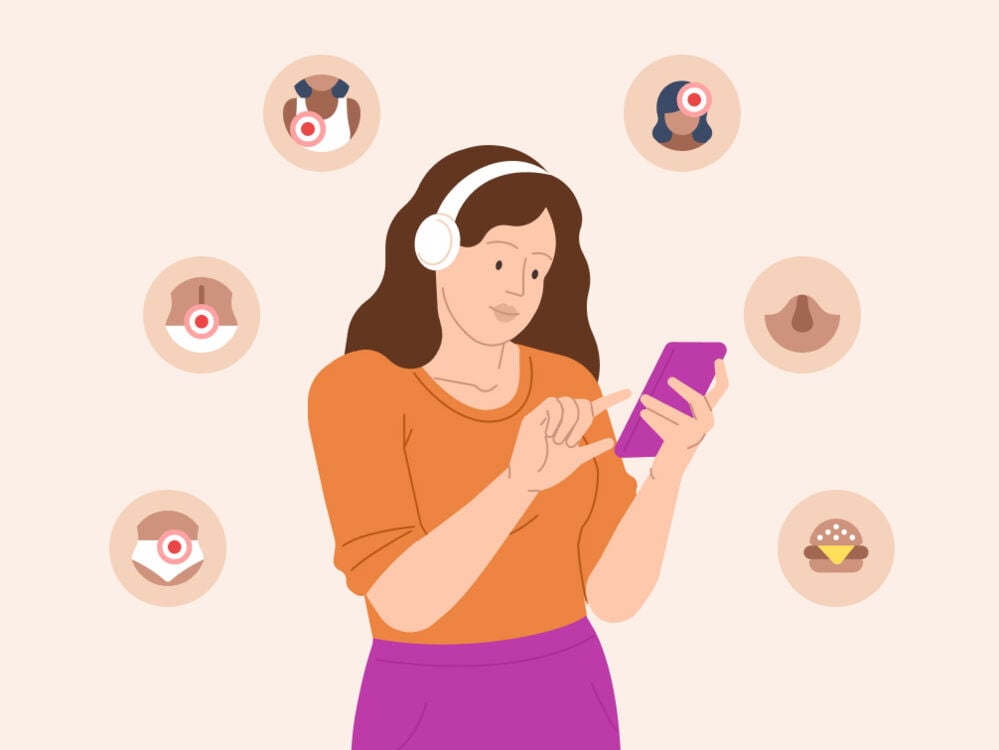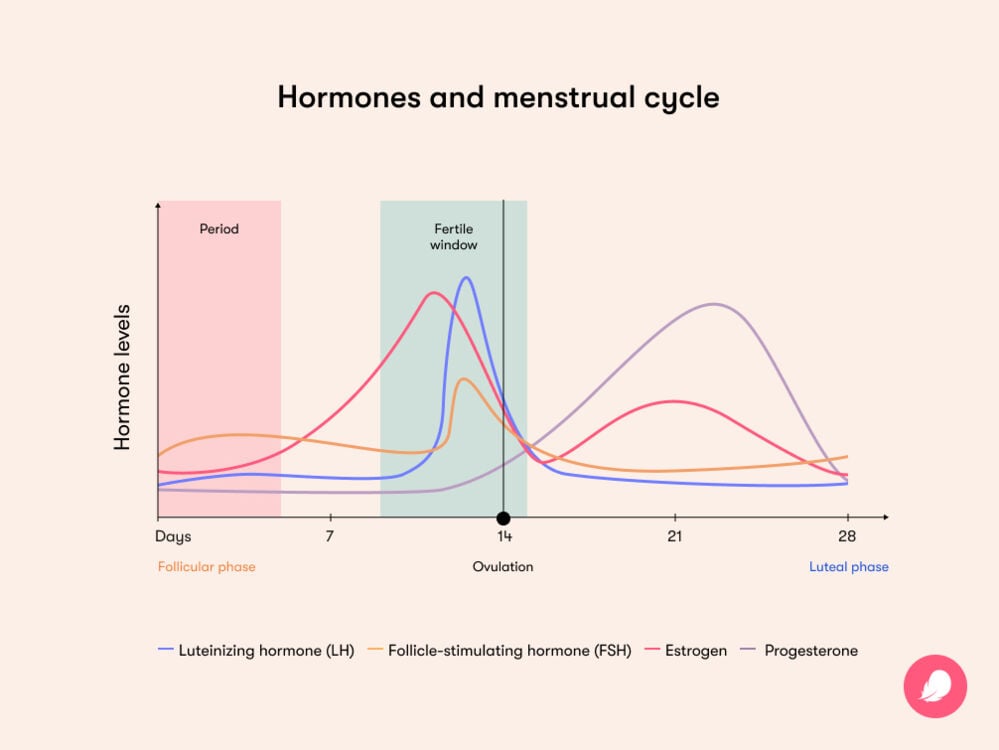Find out what happens during your luteal phase, where it falls in the menstrual cycle, and how it could impact how you feel.
-
Tracking cycle
-
Getting pregnant
-
Pregnancy
-
Help Center
-
Flo for Partners
-
Anonymous Mode
-
Flo app reviews
-
Flo Premium New
-
Secret Chats New
-
Symptom Checker New
-
Your cycle
-
Health 360°
-
Getting pregnant
-
Pregnancy
-
Being a mom
-
LGBTQ+
-
Quizzes
-
Ovulation calculator
-
hCG calculator
-
Pregnancy test calculator
-
Menstrual cycle calculator
-
Period calculator
-
Implantation calculator
-
Pregnancy weeks to months calculator
-
Pregnancy due date calculator
-
IVF and FET due date calculator
-
Due date calculator by ultrasound
-
Medical Affairs
-
Science & Research
-
Pass It On Project New
-
Privacy Portal
-
Press Center
-
Flo Accuracy
-
Careers
-
Contact Us
What is the luteal phase? Know your cycle and symptoms


Every piece of content at Flo Health adheres to the highest editorial standards for language, style, and medical accuracy. To learn what we do to deliver the best health and lifestyle insights to you, check out our content review principles.
When you talk about your cycle, you may just think about your period. However, it’s so much more than that. Your menstrual cycle can be split up into two phases: your follicular phase and your luteal phase. Your period marks the beginning of a new cycle, but there are lots of other things that happen during these phases of your cycle too. Coming to grips with the different phases of your cycle can help you to understand your body better.
The second phase of your menstrual cycle is called the luteal phase (you can read a deep dive into the first phase of your cycle here). It begins on the first day after one of your ovaries releases an egg (known as ovulation) and ends on the day just before your period starts again.
While the follicular phase is characterized by your body preparing for ovulation, your luteal phase is when you might experience some of the symptoms of premenstrual syndrome (PMS), including mood swings, breast tenderness, and fatigue before your period. Here’s everything you need to know about the second part of your cycle.
Key takeaways
- The luteal phase is the second part of your cycle. It follows your follicular phase, which ends on the day of ovulation. While it can slightly differ from person to person and cycle to cycle, your luteal phase can last for around 14 days and will end the day before a new period starts.
- During this part of your cycle, the egg that was released during ovulation may travel down one of your uterine or fallopian tubes to be potentially implanted in the lining of your uterus. If this happens, then you’ll become pregnant. If this doesn’t happen, then the egg will disintegrate, and your body will start to prepare for a new period.
- Both ovulation and your period are triggered by changes in your hormone levels, and you may notice some common premenstrual symptoms in the week before your period starts.
- As your fertile window is classed as the five days before ovulation and one day afterward, it’s still possible to get pregnant during your luteal phase.
What is the luteal phase?
Knowing where you are in your cycle can help you better understand your body and symptoms. So, here’s a quick refresher on the two parts of your cycle: the follicular phase and the luteal phase.
The follicular phase is the first part of your cycle. It starts on the first day of a new period. During this phase, your body prepares an egg to be released during ovulation. The day after ovulation marks the first day of your luteal phase.
Your luteal phase can look a little bit different depending on whether you conceived during your fertile window or not. If you did, then your fertilized egg may travel down your uterine or fallopian tube and implant into the lining of your uterus. If you didn’t get pregnant during this part of your cycle, then your egg can remain viable for up to 24 hours and will then disintegrate.
Take a quiz
Find out what you can do with our Health Assistant
From your period to ovulation, all of the processes during your cycle are triggered by changing hormone levels. During your luteal phase, your body releases the hormone progesterone, either in preparation for a new period or to support you in early pregnancy.
“In the luteal phase, post-ovulation, progesterone is the dominant hormone,” says Dr. Sara Twogood, an obstetrician and gynecologist at Cedars-Sinai Medical Group, who sits on Flo’s expert board. “Progesterone is pro-gestation. This means if a pregnancy has occurred, this hormone helps it to grow. Progesterone is also responsible for many of the PMS symptoms people experience, like constipation and bloating.”
What are common symptoms during the luteal phase?
As your cycle is pretty personal to you, so are some of the signs and symptoms you might experience during your luteal phase. You might not feel any different at all. However, some people report:
Vaginal discharge changes
During your fertile window, around the time of ovulation, your cervical mucus may become stretchy, like egg whites. After ovulation, it might appear thicker or stickier.
Basal body temperature changes
Your basal body temperature is your temperature when you’re completely at rest. During ovulation, it may be slightly higher.

Premenstrual symptoms
You may experience symptoms in the run-up to your period. This could be PMS, but not everyone experiences PMS. Some signs that your period is on the way can include:
- Mood swings
- Feeling tired
- Breast tenderness
- Bloating
- Constipation
- Changes in appetite, including cravings
- Breakouts and spotty skin
- Back pain, especially in the lower back
- Headaches
- Changes in sex drive
You might find it helpful to log any symptoms you experience during your luteal phase in a cycle-tracking app like Flo. By noting the way you feel, you may start noticing patterns in how you might feel at different points in your cycle.
“The phases of the cycle can help explain physical and emotional symptoms that fluctuate throughout the cycle,” says Dr. Twogood. “It can provide reassurance about how the body works and changes.” If you are trying to get pregnant, apps like Flo can give you a rough idea of when you might be ovulating and when the best time to have conception sex might be.
What actually happens in the luteal phase?
As ovulation marks the start of your luteal phase, and you end it by potentially preparing for a new period, a lot happens in the second part of your cycle. So, here’s what’s happening during your luteal phase.
- The luteal phase begins after an egg has been released during ovulation. If you’d like to know more about how your body develops this egg, you can read our guide to the follicular phase here.
- The follicle that released the egg, called the “dominant follicle,” changes into a structure called the corpus luteum.

- The corpus luteum produces the hormone progesterone, along with some estrogen. The increase in progesterone levels prepares the lining of your uterus to thicken. This makes it easier for a fertilized egg to implant into the lining.
- If a pregnancy happens, the uterus lining is maintained, and progesterone levels stay high.
- If a pregnancy doesn’t happen, the progesterone and estrogen levels drop. The lining of your uterus breaks down and leaves your vagina. This is when you get your period.
How long does the luteal phase last?
It can be tough to predict exactly how long your luteal phase will last because everybody’s cycle is slightly different. For many people, their luteal phase lasts between 12 and 14 days. However, if your luteal phase is between 10 and 16 days, it’d be considered normal. You can track your cycle using an app like Flo to get familiar with what’s typical for you.
If the luteal phase lasts less than 10 days, it would be considered short. If it lasts 16 days or longer, then it’d be considered long. This isn’t typically something to worry about, but it may be a good idea to mention it to your health care provider.
People who experience a long luteal phase may have a hormonal imbalance, such as polycystic ovary syndrome (PCOS), which can cause irregular periods. If you don’t get your period as expected, you could also be pregnant. If you have any concerns, speak to your doctor.
What causes a short luteal phase, and how does it affect fertility?
A short luteal phase is when your luteal phase lasts less than 10 days. It’s relatively rare for this to happen. Research has shown that up to around 5% of people experience short luteal phases during their reproductive years.
For some people, a short luteal phase has no noticeable impact, and research has shown that if you notice that your luteal phase is short one cycle but not in others, then it won’t significantly affect fertility in the long term. However, if you’re concerned that your cycle length is impacting your chance of becoming pregnant, then it’s always a good idea to talk with your doctor.
Getting to know your menstrual cycle
As you get to know your menstrual cycle a little better, it’s good to remember that:
- The luteal phase begins on the day after ovulation and lasts until the first day before a new period.
- It can be handy to know when you’re in your luteal phase if you’re cycle tracking or trying to get pregnant. Knowing where you are in your cycle can also prepare you for PMS symptoms.
- You can use an app like Flo to log your symptoms.
FAQs
What are the stages of the menstrual cycle?
On average, the menstrual cycle lasts 28 days. However, if yours is between 21 and 35 days, it’d be considered typical. It can be split into two phases: the follicular phase and the luteal phase, which are separated by ovulation.
What should you do in the luteal phase?
Luteal phase symptoms can resemble those of PMS. A few lifestyle changes can help you to manage these. These include exercising regularly, eating a healthy diet, getting plenty of sleep, meditating, and taking painkillers. Logging your symptoms in an app like Flo can help you to get ahead and prepare for how you might feel, whether that’s making sure you have a hot-water bottle handy or painkillers in the house.
What causes luteal phase defects?
You might have heard the phrase luteal phase defect but not be totally sure what it means. It’s sometimes used when referring to luteal phase deficiency — when your body doesn’t produce enough progesterone after ovulation to thicken and maintain the uterine lining. You might also have a short luteal phase. Although some people who experience this may struggle to conceive, many have successful pregnancies. Speak to your doctor if you have any concerns.


Hey, I'm Anique
I started using Flo app to track my period and ovulation because we wanted to have a baby.


The Flo app helped me learn about my body and spot ovulation signs during our conception journey.


I vividly
remember the day
that we switched
Flo into
Pregnancy Mode — it was
such a special
moment.
Real stories, real results
Learn how the Flo app became an amazing cheerleader for us on our conception journey.
References
“Cervical Mucus.” Cleveland Clinic, my.clevelandclinic.org/health/body/21957-cervical-mucus. Accessed 1 July 2024.
Crawford, Natalie M., et al. “Prospective Evaluation of Luteal Phase Length and Natural Fertility.” Fertility and Sterility, vol. 107, no. 3, Mar. 2017, pp. 749–55, doi: 10.1016/j.fertnstert.2016.11.022.
“Fertilization and Implantation.” Mayo Clinic, www.mayoclinic.org/healthy-lifestyle/pregnancy-week-by-week/multimedia/fertilization-and-implantation/img-20008656. Accessed 1 July 2024.
“Follicular Phase.” Cleveland Clinic, my.clevelandclinic.org/health/body/23953-follicular-phase. Accessed 1 July 2024.
Holesh, Julie E., et al. “Physiology, Ovulation.” StatPearls, StatPearls Publishing, 2023, www.ncbi.nlm.nih.gov/books/NBK441996/.
“Luteal Phase.” Cleveland Clinic, my.clevelandclinic.org/health/articles/24417-luteal-phase. Accessed 1 July 2024.
“Luteal Phase Defect.” Cleveland Clinic, my.clevelandclinic.org/health/diseases/luteal-phase-defect. Accessed 1 July 2024.
“Menstrual Cycle.” Cleveland Clinic, my.clevelandclinic.org/health/articles/10132-menstrual-cycle. Accessed 1 July 2024.
“Menstrual Cycle: What’s Normal, What’s Not.” Mayo Clinic, 22 Apr. 2023, www.mayoclinic.org/healthy-lifestyle/womens-health/in-depth/menstrual-cycle/art-20047186.
Mesen, Tolga B., and Steven L. Young. “Progesterone and the Luteal Phase: A Requisite to Reproduction.” Obstetrics and Gynecology Clinics of North America, vol. 42, no. 1, Mar. 2015, pp. 135–51, doi: 10.1016/j.ogc.2014.10.003.
“Ovulation.” Cleveland Clinic, my.clevelandclinic.org/health/articles/23439-ovulation. Accessed 1 July 2024.
“Premenstrual Syndrome (PMS).” Mayo Clinic, 25 Feb. 2022, www.mayoclinic.org/diseases-conditions/premenstrual-syndrome/symptoms-causes/syc-20376780.
Steward, Kaitlyn, and Avais Raja. “Physiology, Ovulation and Basal Body Temperature.” StatPearls, StatPearls Publishing, 2023, www.ncbi.nlm.nih.gov/books/NBK546686.
“The Menstrual Cycle: Menstruation, Ovulation, and How Pregnancy Occurs.” The American College of Obstetricians and Gynecologists, Jan. 2022, www.acog.org/womens-health/infographics/the-menstrual-cycle.
Thiyagarajan, Dhanalakshmi K., et al. “Physiology, Menstrual Cycle.” StatPearls, StatPearls Publishing, 2022, www.ncbi.nlm.nih.gov/books/NBK500020.
“What Ovulation Signs Can I Look Out for if I’m Trying to Conceive?” Mayo Clinic, 7 Dec. 2022, www.mayoclinic.org/healthy-lifestyle/getting-pregnant/expert-answers/ovulation-signs/faq-20058000.
Witt, Barry. “Trying to Get Pregnant? Here’s When to Have Sex.” The American College of Obstetricians and Gynecologists, Aug. 2023, www.acog.org/womens-health/experts-and-stories/the-latest/trying-to-get-pregnant-heres-when-to-have-sex.




